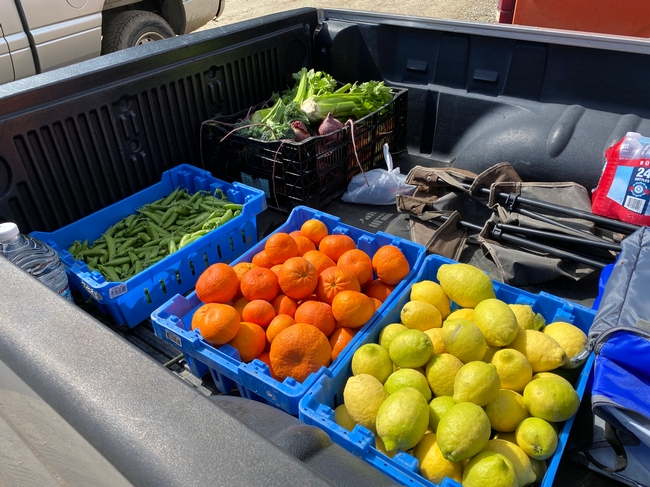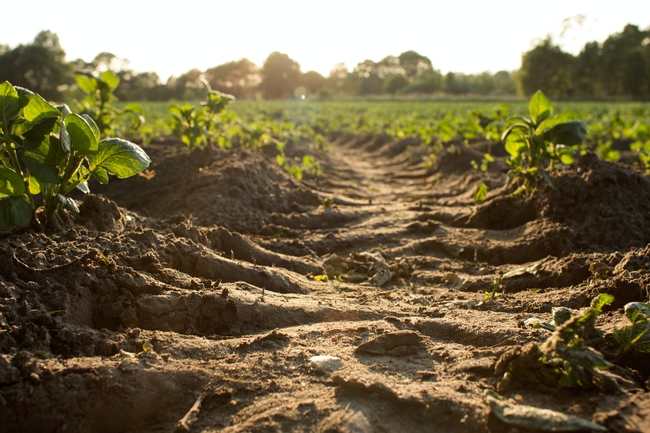
Posts Tagged: HAREC
Fireworks in the Garden: Octopus Agave in Bloom
In this weekly blog, Dr. Annemiek Schilder, Director, UCCE Ventura County and Hansen Agricultural Research and Extension Center, shares her observations about the natural world across the seasons. As she says:
"Gently observing your surroundings with curiosity will teach you some amazing things. There are so many fascinating things happening under our noses, only wanting for an observant eye."
The flowering spikes of the octopus agave (Agave vilmoriniana), currently in bloom in the Master Gardener Demonstration Garden at HAREC in Santa Paula, are seriously impressive at more than 12 feet tall. Octopus agave is a drought-tolerant plant native to the Mexican desert where it grows on rocky ground. The gray-green smooth, twisting leaves with flexible spikes at the tips give the plant an octopus-like appearance. Like other agaves, it is monocarpic, flowering only once in its life before it dies.
Agaves belong to the family Asparagaceae and are therefore related to asparagus. Indeed, young flower spikes may resemble giant asparagus spears. Flowering usually occurs between 6 and 25 years of age. The plant invests all of its energy into producing a spectacular flower display as its last hurrah. The copious small yellow flowers start opening at the bottom of the spike, moving upwards in waves. Flowering may occur over a period of 4 to 8 weeks.
Agave flowers are a magnet for pollinating insects and hummingbirds. However, in their native habitat, nectar-feeding bats, such as the lesser long-nosed bat and the Mexican long-tongued bat, play an important role in agave flower pollination. This may also explain the height of the flower spikes. Bats pollinate at night and are critical for seedset. In the absence of these specialized bats, fewer than 5% of the flowers may produce seed. Commercial cultivation of agave for tequila, which involves cutting off flower stalks, as well as pesticides and habitat destruction have been put forward as reasons for the current endangered status of some of these bat species in Mexico.
In addition to seeds, plantlets called “bulbils” may be produced in large numbers on spent flower stalks. These bulbils are exact clones of the mother plant and will root readily when planted in soil. While clonal reproduction is a good short-term strategy for plant survival, it does limit genetic diversity which makes the species less adaptable to environmental changes in the long term.
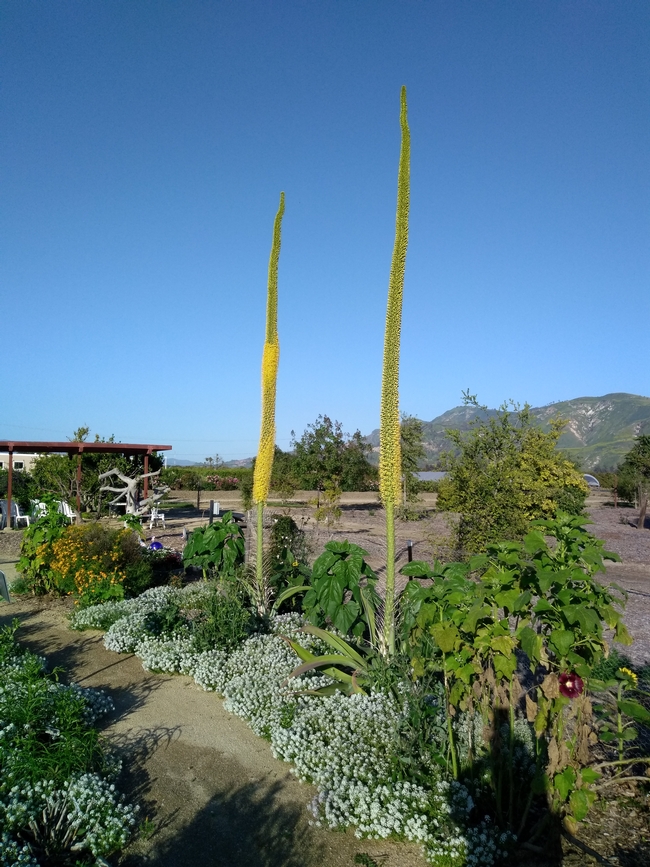
Amazing aphids: strength in numbers
In this weekly blog, Dr. Annemiek Schilder, Director, UCCE Ventura County and Hansen Agricultural Research and Extension Center, shares her observations about the natural world across the seasons. As she says:
"Gently observing your surroundings with curiosity will teach you some amazing things. There are so many fascinating things happening under our noses, only wanting for an observant eye."
During a recent stroll through the Master Gardener Demonstration garden at the Hansen Agricultural Research and Extension Center, a narrow-leaf milkweed plant with stems and leaves covered in yellow caught my eye. A closer look revealed teeming masses of yellow aphids along the stems, as if festively dressing up the plant. But aphids are never a festive sign to the gardener as their voracious feeding stunts plant growth. In addition, their sugary excretions may attract ants and promote unsightly fungal growth called sooty mold.
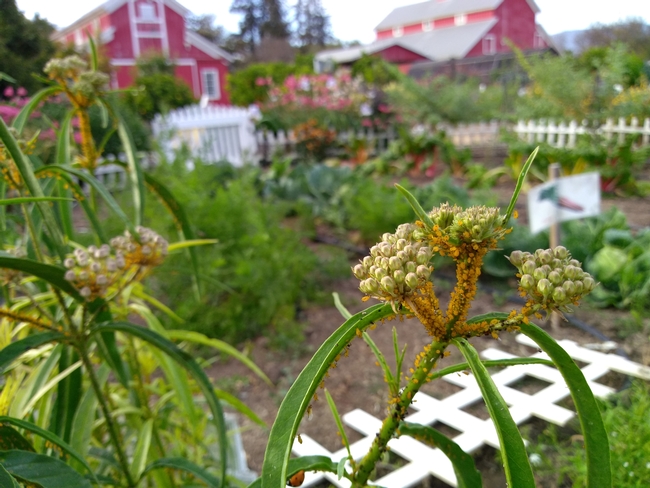
Narrow-leaf milkweed (Asclepias fascicularis) is a perennial plant native to California and an important food source for the caterpillars of monarch butterflies along their migration route. Milkweed plants produce chemicals called cardenolides (cardiac glycosides) that monarchs store in their bodies to protect themselves from predators. Can you guess what part of the body these chemicals act on? Indeed cardenolides speed up the heart rate, making for a rather unpleasant experience for a bird looking for a tasty meal. Narrow-leaf milkweed plants actually have very low levels of cardenolides, but the monarch's striking color pattern is enough to signal toxicity to would-be predators.
Aphids make milkweed plants less hospitable for monarch caterpillars. The striking yellow aphids −Aphis nerii, also called milkweed aphids or oleander aphids−feed on plants in the dogbane family, including oleander, milkweed and periwinkle. They have a yellow pear-shaped body with black legs, antennae and cornicles. Cornicles are the stovepipe-like projections on the aphid's back used to secrete a wax-like substance for self-defense. Aphids are typically wingless until they get too crowded and develop winged individuals that fly away in search of new host plants.
Aphids feed by inserting their mouth parts, which are shaped like a straw, into the plant, sucking up plant sap which contains all the necessary nutrients for the aphid to thrive. The extra sugar and water are excreted as honeydew. Milkweed aphids are able to rapidly colonize plants in the spring and early summer through parthenogenesis, a process whereby female aphids produce female offspring without mating. The aphid daughters, which are exact clones of their mothers, quickly start producing their own babies. In addition, they bypass the egg laying phase by giving birth to live young, which is called vivipary. Looking through a magnifying glass, you may see the little baby aphids being born right in front of your eyes!
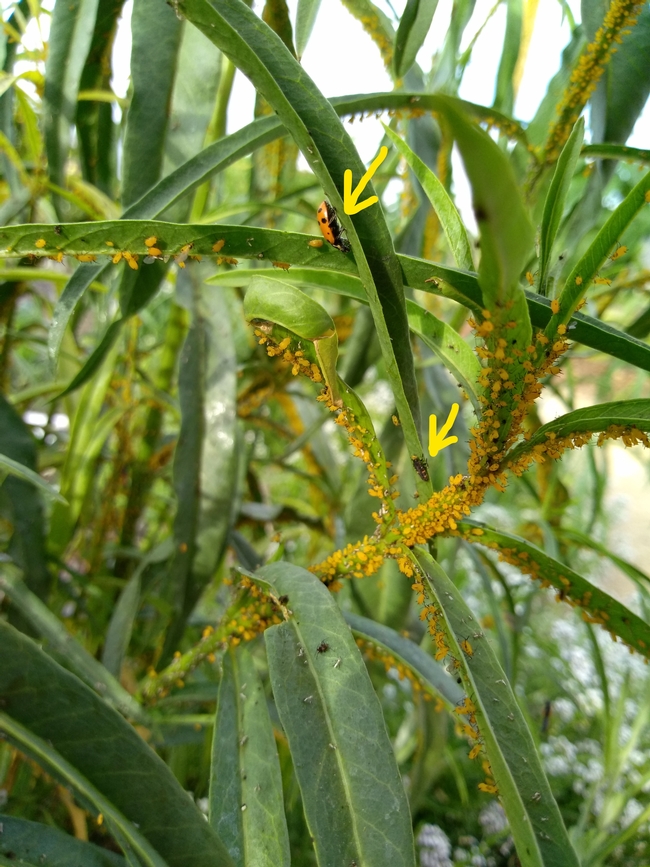
As I was taking some close-up photos, I noticed the aphids intermittently twitching, almost in unison. This strange phenomenon, exhibited by this particular aphid, is called CTKR (Collective Twirling and Kicking Response). It is a collective defense mechanism against natural enemies! By simultaneously twirling their bodies and forcefully kicking their hind legs they discourage natural enemies like parasitoid wasps from attacking them. If you look closely, especially later in the season, you may see evidence of this type of parasitism: little puffed-up aphid bodies with a hole in the middle. These aphids have been parasitized by a wasp larvae which molted into adults and escaped through the hole.
Aphids are like sitting ducks: they usually remain in place while feeding. They will only move if their food runs out or something is irritating them. That makes them a convenient prey for the lady beetle, a very effective natural enemy. In the picture, you can see an adult lady beetle as well as a lady beetle larva, which looks like a tiny black alligator, feeding on aphids. They can eat hundreds of aphids per day and thousands in a life time! Lady beetles are good friends indeed.
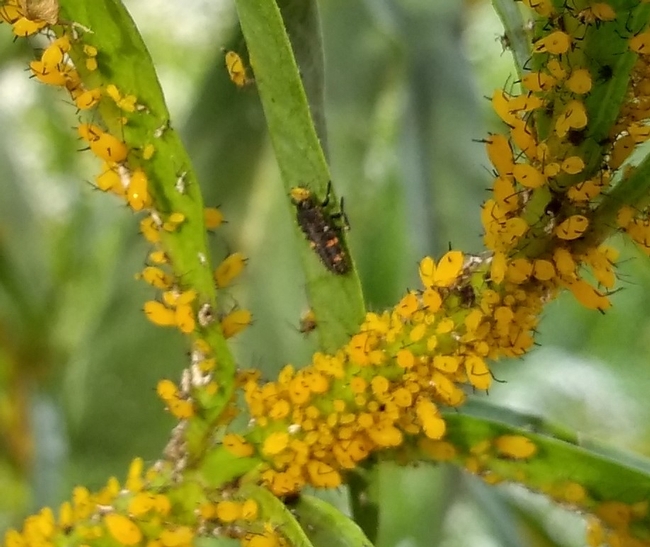
Related Reading:
What's wrong with my peach tree?
UC HAREC donates fruits and vegetables
UC HAREC Donates Fruits and Vegetables to Food Forward and Ventura Schools
Nearly two tons of fruit and vegetables grown at UC's Hansen Agricultural Research and Extension Center (HAREC) in Santa Paula have been donated to Food Forward and the Ventura Unified School District (VUSD), destined for children and families.
Some of the vegetables – planted by volunteers and farm staff - became available when UC HAREC's farm field trips were canceled due to COVID-19. Other vegetables were harvested from the student farm located at HAREC, a partnership with VUSD and the city of Ventura. Kale and lettuce at the student farm were planted by youth from DATA and Montalvo schools.
Every fall and spring, volunteers from the UC Master Gardener program propagate seedlings for schools, bundling them into variety packs of vegetables and herbs, which are given to schools with gardens. Because of COVID-19, plants were given to schools for direct distribution to families. Ventura Unified School District staff partnering in this effort include Kara Muniz, Director of Food and Nutrition Services; Ashely Parrish Decker, Nutrition Educator, who runs the Student Farm; and Alise Echles, RDN.
Additional fruit and vegetables were harvested from HAREC's citrus demonstration area, the site's educational gardens and the farm grounds.
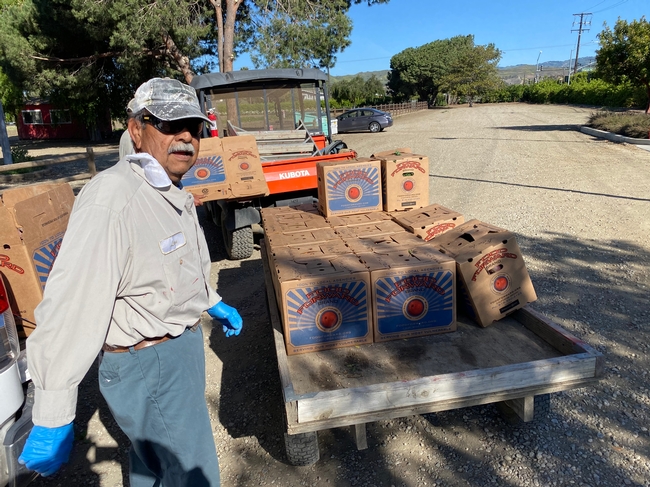
UCCE's education program manager Susana Bruzzone-Miller said, “We are saddened that spring field trip season is cancelled and miss the sound of children delighting in harvesting, sometimes for the very first time. But, it warms my heart that our field trip garden can help feed so many families in need.”
John Antongiovanni, farm manager, worked with the farm staff to organize the harvest. He said, “Working together during this difficult time is very rewarding.”
Food Forward is a gleaning organization that helps residents turn the surplus produce grown on their property into a nutritious food source for local communities. Rick Nahmias, founder and executive director, indicated that the Food Forward Backyard Harvest team remains active, and may be reached via phone at 805.630.2728 or email.

IMG 20200420 153035966 HDR
4-H Distance Learning Resources Available, Hedgerows for Healthy Soil and More
Online Educational Resources
Since we're all learning and working from home, our education team has created a virtual learning page packed with wonderful resources about agriculture. You can enjoy these lessons and stories from your computer, tablet or phone. Check back often, as we're adding content.
The Buzz About Hedgerows
Hedgerows are an approved practice under California Department of Agriculture's Healthy Soils Grant Program. That means, growers are eligible to receive grant funding for planting hedgerows. But what exactly are the benefits of hedgerows and why are they worth planting? As a perennial planting it can have immediate impacts on the soil, but what else? The answer lies largely in the pollinators and beneficial insects they attract.
Read the latest from our #climatesmart #ag community education specialist Alli Fish.
Resources You Can Use
University of California researchers and program staff are working to answer questions and provide information and resources relating to the food system and COVID-19. Check out this post, which contains resources about food and farm safety, gardening and more.
UC ANR Expands the Role & Reach of its Sustainable Ag Program
University of California vice president for agriculture and natural resources Glenda Humiston has announced changes to UC ANR's Sustainable Agriculture Research and Education Program (SAREP).
"Since 1986, SAREP has supported scientific research and education to advance agricultural and food systems that are economically viable, sustain beneficial ecosystem services, and enhance the quality of life in local communities. Moving forward, California farms and food systems face an ever-larger set of challenges: shifting consumer demands,invasive pests, climate change, additional regulations, lack of access to labor, and more. The need for new technologies, better systems and effective problem-solving is greater than ever.
“UC ANR envisions positioning SAREP to serve as a much broader umbrella of sustainability, addressing all aspects of the triple-bottom-line: people, planet and prosperity,” Humiston said. “To accomplish this, SAREP will provide leadership and support to several promising initiatives and will facilitate our ability to capture synergies among them. Those include agritourism, ecosystem services, regional food systems, community and economic development and more.”
The full announcement is available here.
Are You Following Us on Social Media?
We'd love to see you on Facebook and Instagram. Follow us for news and information you can use.
Have a great week!
Cooking with Herbs
Cooking is one of my greatest joys. So, when Master Gardener lead, Susan Carter asked me to teach a Cooking with Herbs class for fellow gardeners last year, I jumped at the chance. I was even more thrilled to be invited back for a command performance. A...

Cooking with Herbs Class

20190417 104639

20190417 093354

20190417 104244

20190417 104308

